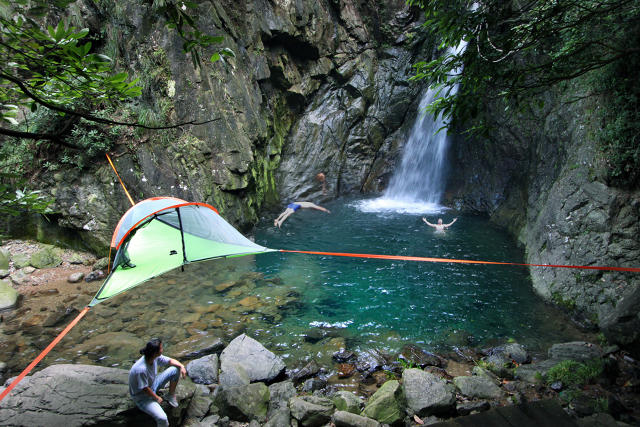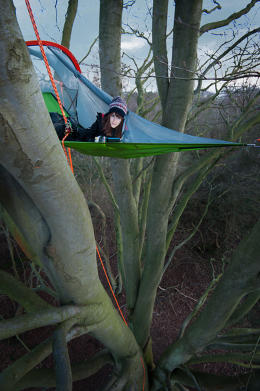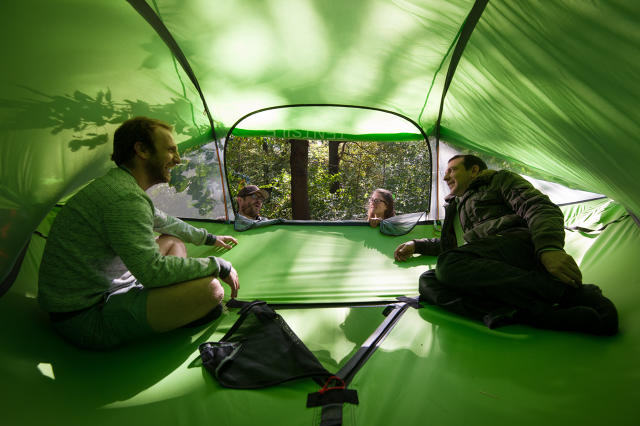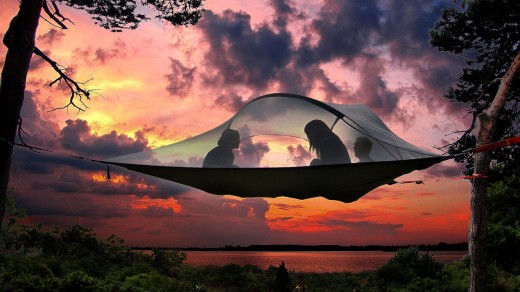How One Startup Is Elevating camping With A Tree home You raise With You
After a design theft in China and amid a rising market, how the tree-tent firm Tentsile is making waves in camping and ecotourism.
February 26, 2015
Alex Shirley-Smith was once a tree house architect. In 2013, bored to death with designing custom-made suspended abodes that bordered on the extravagant for his rich clients, he lower back to earth and decided to find a new manner up. With a chum, Kirk Kirchev, he set to work designing a tent that might operate so much the identical function as those properties: lifting folks above nature and, he thinks, elevating the entire experience of tenting.
His London-primarily based firm, Tentsile, makes robust tree tents that supply ecotourists the amusement of sound asleep in a tree home without the hassle of permanence or worth. though it is most effective two years old, Tentsile is already striking deals with retailers like REI and Backcountry.com, amongst other global retailers and distributors, who recognize what could also be a rising development.
The tenting trade is returning to pre-recession levels, and ecotourism holidays are on the upward push too. in line with a 2012 survey on TripAdvisor, seventy one% of respondents mentioned they might make environmentally pleasant shuttle selections inside the next one year, up six share points from the 12 months earlier than. most of these vacationers are curious about journeying untouched, pure terrain whereas giving back to the local community.
in the world of tenting and out of doors sports activities, tree tents fill a space that’s someplace between the extraordinary activity of vertical tenting, which is well liked by rock climbers, and hammock tenting, for solo hikers. Vertical campers use moveable putting tent techniques known as portaledges, or portable ledges, to droop a rigid cot from one anchor level after they want to take a nap on the facet of a mountain.

as of late, tree tents have popped up at ecoresorts as a minimally invasive camping way, or as a brand new option at motels that cater to glamping enthusiasts—travelers who searching for out a novel camping experience. (Yurts are well-liked.)
but these tents do not tend to be portable, and are not low-cost. An orb-formed luxury tree tent called the Cocoon Tree goes for around $8,000, weighs one hundred thirty pounds, and takes two days to bring together with the help of a skilled climber. another luxury tree tent referred to as the Roomoon starts at $5,800. The product design agency Luminair also makes a nonportable tree house—tent hybrid that a U.ok. campsite plans to roll out for guests to stay in. another British firm called Treepee makes a tent-trampoline combination that has 4 floor supports and one overhead placing support. in all probability essentially the most similar tent to Tentsile’s tents comes from a Vermont-primarily based company known as Treez Tree Tents, however it only bargains one- and two-particular person models. nonetheless, the two-person adaptation prices $1,499 and takes weeks to ship.
Tentsile, meanwhile, has been in a position to sell its tree tents for a fraction of the associated fee of its rivals, with models starting from $500 to $1,500. The Stingray, its flagship tent, can accommodate three folks and takes two people about 10 minutes to set up. In a year, the corporate says, it can be sold over 3,000 of them globally. alongside the best way, it had to deal with an IP-theft fiasco in China and a remaking of its production process.
lower away the excess
5 years ago, Shirley-Smith started tinkering around with tree-tent designs in his free time. the first version of his tree-spun tent used to be a dodecahedron design, identical in shape to its luxury peers. Internally it was once known as “large Mama,” externally as the large. It weighed nearly eighty five pounds and used to be too tough to manufacture. still, people loved the design in Tentsile’s native U.okay. It garnered some preliminary traction on green design forums. And in 2012, the giant bought a plug on national tv. Tentsile’s web site obtained forty,000 hits in 24 hours.
just after Tentsile’s first exposure on tv, he hired Kirchev, a product dressmaker, to help flip the giant right into a manufacturable product.
There was just one downside: the giant couldn’t accommodate the dynamic loads that come with people moving around inside of a tent; the construction tended to warp, very like a hammock does when folks transfer round on one. And Shirley-Smith wanted so to strengthen eight folks directly. the quantity of subject material he would have wanted to do this would have made the associated fee prohibitive.

all through a yr of product revisions, Kirchev helped Shirley-Smith streamline the giant to accommodate three people and prep it for manufacturing. The pair thinking about the design means that inspired their company’s identify: tensile structures, which are fabricated from lightweight supplies held in rigidity to reduce the necessity for added structural supports. the brand new design included a robust material that has a honeycomb lattice, helping turn their heavy prototype into a extra based sail of a tent. known as the Stingray, it’s now Tentsile’s flagship product, sells for $675, and weighs 20 pounds.
To pitch the Stingray and all of Tentsile’s products, you need three timber—or three in any other case secure pillars. The three webbed helps radiating out from the tent are held in stress and on the anchor factors with ratchet straps. regardless of how insect- or animal-weighted down, rocky, or wet the bottom stipulations are, so long as you will see three helps, which you can pitch the tent. but when the ground is fine, you’re free to pitch the tent on the ground, too.
“Our tents should not best straightforward to make; they are fun, they may be relaxing, and just a bit bit attractive,” says Robert Shirley-Smith, Alex’s brother, who joined the Tentsile group just after the Stingray went to production. by using 2013, Tentsile began to sell so many tents that Alex and Kirchev may end their day jobs; quickly they determined to maneuver their production to China.
See your design to the market your self
to start with, Tentsile partnered with a massive manufacturing facility that made tents for other camping brands, like Quecha. but the Tentsile workforce wasn’t comfortable with the manufacturing facility’s workmanship. Shirley-Smith and Kirchev pooled their cash to purchase a new manufacturing facility within the metropolis of Ningbo. And Kirchev moved to China. (“His children go to high school there,” Robert says. they’re “now arguing with each and every different in chinese language,” he adds, but Kirchev’s chinese is “limited.”)

quickly after, the chinese language executive shut Tentsile’s new manufacturing unit down. It became out that the previous manufacturing facility’s administrators accused Tentsile of stealing designs from them. all through a one-month felony struggle within the chinese language court system, 231 consumers waited on their shipments, however Tentsile sooner or later received and resumed operations.
“With us no longer being there, we didn’t have our eyes and ears on what was once happening,” says Robert.
Now, the Shirley-Smith brothers direct Tentsile’s day-to-day operations in London, whereas Kirchev runs Tentsile’s Ningbo manufacturing unit. The factory’s body of workers of 17 produce seven hundred to 800 tents per month; production is smoother and quicker, and fees are down.
“Kirk shifting to China has truly introduced down the price of production,” says Robert. with no intermediary to pay, Tentsile may cut back its end worth with the aid of more than 50%. The retail price of the Stingray dropped from $1,499 to $675.
within the process, Tentsile became the principal player in the growing market of increased tents. And closing 12 months, it began making a new range of tents designed to connect with the Stingray and each and every different. The join is a smaller and modular model of the Stingray that may link up with different Tentsile tents in a series to kind a web of tents. (In January of this 12 months, Tentsile created one such community at the Sequoia national Park.) some other adaptation, the Vista, features a removable roof. Add a few of Tentsile’s new Trillium hammocks, and that you may bring together a nine-person tree-tent bunk mattress. there is also the colossus of tree tents: the Trilogy tremendous-Tent, which consists of three modular connect tents, conjoined with a cover.

some other large spoil got here 9 months in the past, when the tenting provide giant REI started selling Tentsile’s tents on its web page. It was once the company’s first retailer, and its first introduction to the U.S. market. consistent with probably the most recent American Camper document by using The outdoor groundwork and outside massive Coleman, forty million americans went camping in 2013, or 14 p.c of the population, a number that has remained mostly consistent in up to date years. the global marketplace for tenting tools is expected to achieve $5 billion by 2019, stories Lucintel, a consumer research firm, as consumers substitute older tools for ones with new tech and supplies and spend extra on game. A retiring inhabitants looking for outside recreation is another supply of increase, the report mentioned.
while most of Tentsile’s sales have come from its web page up unless now, the company foresees extra job this year via its new offers with shops, like REI and Backcountry.com in the U.S. and Bergfreunde.de in Germany. The group also has a distribution maintain the travel website online GlobeTrotter.com.
On its REI review page, purchaser feedback concerning the Stingray are principally sure, with reward for its handy measurement, set-up time, and cool issue. (One consumer complained in regards to the high quality of the stitching.) One Stingray proprietor wrote:
good now not waking up in a puddle of water after heavy rains. counsel putting in off the overwhelmed direction as you’ll be by using folks asking you question[s]. I set it up on an island on [a] canoe go back and forth and nonetheless had boaters cease and comment on it.
find just right, global companions
For a bunch of nature fanatics, the Tentsile workforce is intensely wired into the tech world. The site is powered by way of Shopify. It accepts Stripe. They duly update the facebook web page, Instagram feed, YouTube channel, and blog. and they ship globally simply, thru a company known as Shipwise, which lets Tentsile ship anyplace from five shipping depots around the globe. “We literally simply click a couple of buttons, and it’s done,” Robert says.

in addition to a good logistics associate, Tentsile works with distributors who believe within the brand. Tentsile’s South Korean distributor prominently options Tentsile’s history story on her web page’s welcome page. “folks in South Korea need to hear these stories, too,” Robert says.

Plant bushes Too
Tentsile is not best excited about earnings; it is the use of its business to offer protection to the timber its customers rely on. The crew has partnered with WeForest.org to lend a hand prevent forests from needless destruction. for every tent Tentsile sells, WeForest.org crops three bushes in tropical forests.
the company’s conservationist ethos has helped it burnish its ecotourism credentials. at the finish of 2013, Tentsile paired up with an NGO to create a self-contained ecovillage in Fiji the use of its tree tents. tourists searching for an alternative to the island’s hotel lifestyles may stay in the tents, positioned within the rain forest and equipped with the aid of the ecovillage’s personal natural garden. Tentsile additionally offers camping programs in Cambodia and Finland, complete with courses and chefs. (The three-day expedition in Finland costs €855 [$970] per particular person.) It also sees markets past tourism and camping. Expeditions, natural world filming, scientific analysis, festivals, safaris, and humanitarian reduction scenarios are all ideal venues for Tentsile’s tents, in line with the corporate’s web page.

nonetheless, tree tents face a protracted climb up the camping gear ladder. Dan Zenkel, a summer season camp consultant, says he isn’t certain that tree tents have discovered a following in the tenting world simply but. however he knows that traditional tree houses enchantment to youngsters at summer camps. And this is a compelling market for the tenting business: as the authors of the American Camper record be aware, most American campers commence tenting at age 15 and youthful.
“a lot of summer time camps are offering tree properties to children to sleep in. There’s a possibility there for these tents,” says Zenkel. they offer a enjoyable part that common tents don’t, and “they’re cheaper”—at least less expensive than constructing a tree home.
[image credit: Tentsile]
(227)














